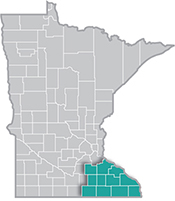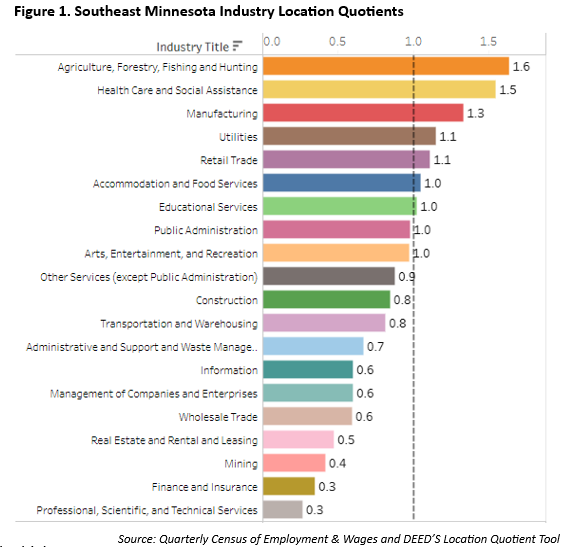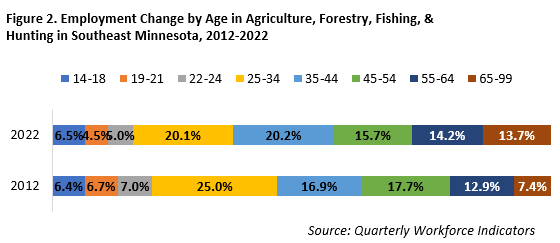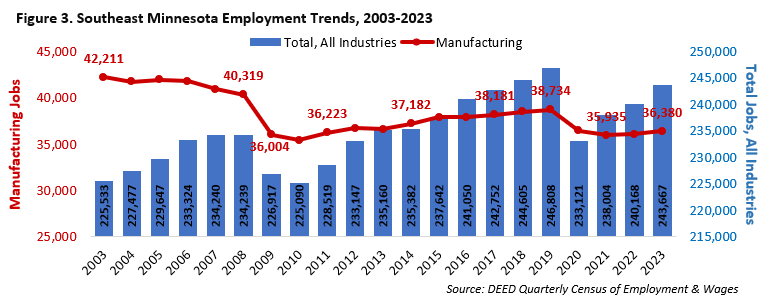 Southeast Minnesota is a health care and agricultural powerhouse. The region is home to the renowned Mayo Clinic and some of the world's most recognized food companies and brands.
Southeast Minnesota is a health care and agricultural powerhouse. The region is home to the renowned Mayo Clinic and some of the world's most recognized food companies and brands.
Advanced manufacturing is especially strong here, with machinery, chemicals, and electronics among the top products.
Want the freshest data delivered by email? Subscribe to our regional newsletters.
5/28/2024 9:00:00 AM
Amanda O'Connell
According to the Minnesota Department of Employment & Economic Development's (DEED) Location Quotient Tool, Southeast Minnesota has a higher concentration of employment in sectors such as Agriculture, Forestry, Fishing, & Hunting, Health Care & Social Assistance, Manufacturing, Utilities, and Retail Trade compared to the state as a whole.

Location Quotients (LQ) measure an industry's employment density within a specific region relative to that industry's density in a broader benchmark area. An LQ of 1.0 indicates that the local area's employment density matches that of the larger reference area, in this case the entire state of Minnesota. An LQ above 1.0 suggests a higher concentration of employment in the local area for that industry. Conversely, an LQ below 1.0 indicates a lower employment concentration in the region compared to the state.
This article will explore the top three industries with the highest LQs in Southeast Minnesota.
At 1.6, Southeast Minnesota's highest LQ is found in the Agriculture, Forestry, Fishing, & Hunting industry. In 2023, there were 3,200 jobs at 427 firms providing an average annual wage of $44,512. Since 2003, Southeast Minnesota has added 1,214 jobs in this industry, a 61.1% increase. The highest number of jobs was observed in 2021, with 3,260 jobs, but jobs have dropped slightly since then.

Over the past decade, the Agriculture industry in Southeast Minnesota has seen a notable demographic shift. While there has been a significant retention of middle-aged and older workers, the industry has witnessed a decline in younger workers. This trend is more pronounced in Agriculture than across all industries. From 2012 to 2022, there was a 22.3% increase in workers aged 55 to 64 years, and a 105% surge in those aged 65 years and older. In contrast, across all industries, the increase was 11.2% for workers aged 55 to 64 and 49.2% for those 65 years and older.
Southeast Minnesota has the highest LQ of the six planning regions for Health Care & Social Assistance, at 1.5. In 2023, this sector had 66,409 jobs and 1,982 firms in the region, accounting for over a quarter (27.3%) of employment in Southeast Minnesota. This industry has recovered all jobs lost since 2019 due to the pandemic, after adding 916 jobs within the past year.
Southeast Minnesota's healthcare sector still has strong demand for workers, a need that is expected to persist in the future. According to DEED's Occupation in Demand Tool, 53 healthcare-related jobs are in high demand in the region, ranging from Home Health & Personal Care Aides to Physicians. Between 2020 and 2030, the Healthcare Practitioners & Technical and Healthcare Support occupational groups are projected to account for 43,642 total hires in the region. This represents 14.6% of the total hires projected in Southeast Minnesota during this decade (Table 1).
| Table 1. Healthcare Employment Projections, 2020-2030 | |||||||
|---|---|---|---|---|---|---|---|
| Occupation | Estimate Employment 2020 | Projected Employment 2030 | Percent Change | Total Change | Labor Force Exit Openings | Occupational Transfer Openings | Total Hires |
| Total, All Occupations | 261,589 | 274,824 | +5.1% | +13,235 | +116,573 | +168,926 | +298,734 |
| Healthcare Practitioners & Technical | 33,186 | 36,036 | +8.6% | +2,850 | +8,417 | +9,643 | +20,910 |
| Healthcare Support | 16,267 | 18,262 | +12.3% | +1,995 | +10,457 | +10,280 | +22,732 |
In Southeast Minnesota, the Manufacturing industry holds an LQ of 1.3, ranking second highest among the six planning regions, tied with Central Minnesota. This sector includes 662 establishments, which provided 36,380 jobs in 2023. Manufacturing jobs represent 14.9% of the region's total employment, making it the second-largest industry, trailing only Health Care & Social Assistance.
Manufacturing employment has changed over time. During the 2009 recession, there was a loss of 4,300 jobs in the region, with the sector's employment dropping to its lowest level of 35,398 jobs in 2010.
Since then, there has been a gradual recovery in jobs in the region. Then the Pandemic Recession led to another significant decrease, with a loss of 2,800 jobs between 2019 and 2021. Since 2021, the Manufacturing industry has added 445 jobs, though it has not yet returned to pre-pandemic employment levels (Figure 3).

The Agriculture, Forestry, Fishing, & Hunting, Health Care & Social Assistance, and Manufacturing industries are crucial to Southeast Minnesota's economy. Each of these industries has a location quotient that surpasses the state average, highlighting their significance within the region. Despite facing challenges such as demographic shifts and economic recessions, these sectors have shown resilience and remain key contributors to the regional economy.
Contact Amanda O'Connell, Labor Market Analyst, at amanda.oconnell@state.mn.us.